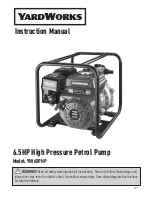
16
www.evolutionpowertools.com
During operations the use of a dust extraction
machine will help keep the workplace clean
and dust free, enhancing operator safety and
comfort and aiding operator cutting accuracy.
CUTTING ADVICE
Note: Always ensure that the footplate of the
jigsaw is in close contact with the workpiece
throughout the cutting procedure. If the
footplate is allowed to ‘lift’ away from the
workpiece operator control and accuracy will
be compromised.
• Clearly mark out the cutting line to be
followed on the workpiece (use a pencil or
other suitable marking device).
• Small workpieces should be secured in a
vice or clamped to a workbench. Check that
the passage of the blade is not obstructed.
• Larger workpieces should be clamped to
sawhorses or similar. Check that the passage
of the blade is not obstructed.
• Set the Cutting Action Selection Lever to the
desired position.
• Align the saw with the cutting line and rest
the front of the footplate on the workpiece.
Note: Ensure that the blade is not in contact
with the workpiece at this stage.
• Switch the machine ‘On’ and gently feed the
jigsaw into the workpiece. Be careful to hold
the jigsaw firmly and keep full control as the
blade contacts the workpiece.
• Adjust the speed of the blade as necessary
to achieve optimum cutting performance.
• Use the Laser guide if necessary, but only on
non-reflective materials.
Note: Do not force the blade. Let the blade do
the work by adjusting the speed and feed rates
to achieve best performance.
CUTTING METAL
When cutting any metal a suitable cutting
lubricant/coolant should be used. Cast Iron and
Brass can be cut without a cutting lubricant.
Always use a blade that is capable of cutting
metal, and secure the workpiece securely,
if practicable, in a vice or similar clamping
device.
WARNING: When cutting metal the Cutting
Action Selection Lever must be set to the ‘0’
position.
CUTTING CIRCLES OR CURVES
When cutting curves, particularly tight
curves, start with a reasonably slow speed,
and gradually increase the speed until the
optimum performance is achieved. Do not
force the blade, as in curved cutting this can
lead to the blade deflection, and possible
blade breakage.
To cut a circle from a workpiece:
• Mark out the circle in the required postion.
• Drill a ø12 mm hole near the centre of the
circle.
• Insert the jigsaw blade into the ø12 mm
hole. Ensure that there is clearance between
the blade and the workpiece.
• Begin cutting towards the outside of the
circle, slowly in a spiral fashion, until the
blade is following the required cutting line.
• Advance the jigsaw slowly to avoid cutting
a slanted surface or experiencing blade
deflection.
ANGLED CUTTING
Angled cutting, whatever the material, is
always more difficult than general straight
cutting. With angled cutting it is very important
to allow the saw blade to do the work. Do
not ‘force’ the blade. A trial run on unwanted
material to determine the best combination of
blade feed and speed is recommended.
Return to the factory setting when angled
cutting is completed. Recheck the security of
the blade.
BLADES
Choose blades carefully. Use only a blade that
is suitable for this machine and for the material
to be cut.
Содержание RAGE7-S
Страница 19: ...19 www evolutionpowertools com EN DE...





































